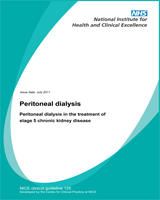All rights reserved. This material may be freely reproduced for educational and not-for-profit purposes. No reproduction by or for commercial organisations, or for commercial purposes, is allowed without the express written permission of NICE.
NCBI Bookshelf. A service of the National Library of Medicine, National Institutes of Health.
Peritoneal Dialysis: Peritoneal Dialysis in the Treatment of Stage 5 Chronic Kidney Disease. London: National Institute for Health and Clinical Excellence (NICE); 2011 Jul. (NICE Clinical Guidelines, No. 125.)

Peritoneal Dialysis: Peritoneal Dialysis in the Treatment of Stage 5 Chronic Kidney Disease.
Show details1.1. List of all recommendations
Information and support
- 1.1.1.
Offer patients with stage 5 chronic kidney disease (CKD) and their families and carers information and support in line with ‘Chronic kidney disease’ (NICE clinical guideline 73, 2008).
- 1.1.2.
Offer patients and their families and carers oral and written information about pre-emptive transplant, dialysis, and conservative care to allow them to make informed decisions about their treatment.
- 1.1.3.
To enable patients to make informed decisions, offer balanced and accurate information about all dialysis options. The information should include:
- a description of treatment modalities (assisted automated peritoneal dialysis [aAPD], automated peritoneal dialysis [APD], continuous ambulatory peritoneal dialysis [CAPD], and home or in-centre haemodialysis) including:
- –
efficacy
- –
risks
- –
potential benefits, based on the person’s prognosis
- –
potential side effects and their severity
- –
changing the modality of dialysis and the possible consequences (that is, the impact on the person’s life or how this may affect future treatment or outcomes)
- a discussion about how treatment fits into people’s lives, including:
- –
the patient’s and/or carer’s ability to carry out and adjust the treatment themselves
- –
integration with daily activities such as work, school, hobbies, family commitments and travel for work or leisure
- –
opportunities to maintain social interaction
- –
the impact on body image
- –
how the dialysis access point on the body may restrict physical activity
- –
if their home will need to be modified to accommodate treatment
- –
distance and time spent travelling for treatment
- –
flexibility of treatment regimen
- –
any additional support or services that might be needed from others.
- 1.1.4.
Explain to patients and check they understand that CKD is a lifelong disease, and that during the course of renal replacement therapy they are likely to need to switch between treatment modalities depending on clinical or personal circumstances.
- 1.1.5.
When providing information about treatment options, healthcare professionals should discuss and take into account any information the patient has obtained from other patients, families and carers and all other sources, and how this information has influenced their decision.
- 1.1.6.
Make sure that healthcare professionals offering information have specialist knowledge about CKD and the necessary skills to support decision-making. This may include training in:
- using decision aids to help patients make decisions about their care and treatment
- presenting information to children in a form suitable for their developmental stage, such as play therapies.
- 1.1.7.
Trained healthcare professionals (see recommendation 1.1.6) should be available to discuss the information provided both before and after the start of dialysis.
- 1.1.8.
Offer all patients who have presented late, or started dialysis treatment urgently, an enhanced programme of information, at an appropriate time, that offers the same information and choices as those who present at an earlier stage of chronic kidney disease.
Choosing dialysis
- 1.1.9.
Offer all people with stage 5 CKD a choice of peritoneal dialysis or haemodialysis, if appropriate, but consider peritoneal dialysis as the first choice of treatment modality for:
- children 2 years old or younger
- people with residual renal function
- adults without significant associated comorbidities.
- 1.1.10.
When discussing choice of treatment modalities, healthcare professionals should take into account that people’s priorities are not necessarily the same as their own clinical priorities.
- 1.1.11.
Before starting peritoneal dialysis, offer all patients a choice, if appropriate, between CAPD and APD (or aAPD if necessary).
- 1.1.12.
For children for whom peritoneal dialysis is appropriate, offer APD in preference to CAPD if they are on a liquid diet, especially if they have low residual renal function.
Switching treatment modalities
- 1.1.13.
Do not routinely switch patients on peritoneal dialysis to a different treatment modality in anticipation of potential future complications such as encapsulating peritoneal sclerosis. However, healthcare professionals should monitor risk factors such as loss of ultrafiltration and discuss with patients regularly the efficacy of all aspects of their treatment.
- 1.1.14.
Consider switching treatment modality if the patient, their family or carer asks.
- 1.1.15.
When considering switching treatment modality, offer information on treatment options described in recommendations 1.1.1–1.1.8. This should also include how any decision to switch may affect future treatment options.
- 1.1.16.
Switching between treatment modalities should be planned if possible.
- Summary - Peritoneal DialysisSummary - Peritoneal Dialysis
Your browsing activity is empty.
Activity recording is turned off.
See more...